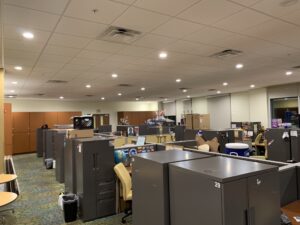CLCE plans to revamp third-floor MSC space

Students looking for a place to meet with their student organization amid the overcrowdedness of the Marshall Student Center (MSC) during the school year might have a new option.
New plans to refurbish the office space on the third floor of the MSC for student organizations are in discussion after a proposal by Student Body Vice President Travis McCloskey.
The project will focus on revamping the storage of student organization resources and providing a flexible space for student organizations to work and collaborate on similar projects, according to the Director of the Center for Leadership and Civic Engagement (CLCE), Mike Severy.
Items being added to the space include movable chairs, folding tables and more storage for student organizations.
Led by McCloskey, in collaboration with the CLCE, the project consists of reorganizing the office space to support a larger percentage of student organizations.
McCloskey was not available for comment by the time of publication to discuss his involvement in the project.
A survey was conducted between August and September to collect data from student organization leaders and advisors in regard to the use of the office space. With the data collected, a new proposal will be drafted and then given to McCloskey for further consideration.
The current office space has the capacity to house 32 cubicles assigned to a certain number of student organizations, including the Students of India Association (SIA), Latin America Student Association (LASA) and the Pre-Medical American Medical Student Association (PAMSA).
In order to rent a cubicle, student organizations are required to apply at the end of every academic year for further consideration.
With the project, the CLCE plans to provide an open-concept floor plan without designated cubicle spaces for clubs and organizations that previously had one.
Severy said the current layout of the office space doesn’t allow the department to fully support the majority of student organizations throughout the year due to limited space.
“We have around 32 cubicles upstairs, which serves less than 5 percent of our student organization population of over 650 student organizations,” Severy said.
“We were not able as [the CLCE] to lean into supporting student organizations as well as we could, primarily because of the resource base that we have available to us. If we had a greater degree of flexibility in space and resources, we can better serve our student organization.”
Based on the survey data, Severy said that there was a need to incorporate more student organizations into the office space.
The cost established by the office furniture supplier Holmes and Brakel to furnish the room is around $40,000 to $50,000, according to Severy. The official cost hasn’t been announced yet.
Severy said that the funding would most likely come from SG’s unallocated cash request.
Two and a half years ago, the CLCE submitted a proposal to SG consisting of redesigning the current office space. However, when presented to the Senate, the funding did not get approved.
According to Winston Jones, the associate dean of students, the original idea was to provide a facility for not only 32 clubs, but for the whole population of more than 600 student organizations.
“The goal was to create a more organizational space where all organizations could come in, do work and have a common space to work together,” Jones said.
The idea was brought up again in the spring with McCloskey’s election. According to Severy, McCloskey approached the CLCE with the idea to rekindle the plan.
“The reimagining of the third-floor space to a flexible space allows the CLCE to live into our mission as it relates to training, education and development for leadership within student organizations,” Severy said. “Having a dedicated space to do student organization training and development experiences provides a little bit more flexibility.”
According to Severy, students might start seeing a change in the office space by the end of the spring semester.
“It provides another opportunity for student organizations to focus on their student organization work,” Severy said. “Certainly, probably foresee that student organization might be able to reserve it for various things as we don’t want to turn it into another room on the inventory of the Marshall Student Center where that’s always reserved and people can’t use. We don’t want to get into that. But I want it to be as useful as possible in supporting students.”







